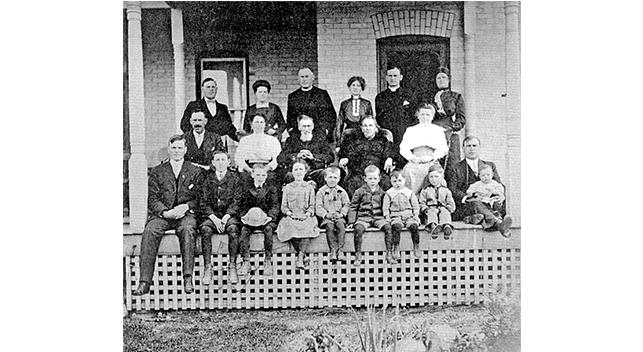
Indigenous Erasure and T. B. R. Westgate
T. B. R. Westgate and his family at Watford, Ontario. Photograph from Lambton Heritage Museum. Westgate – Lambton County Museums (lambtonmuseums.ca)
This post is a follow-up to week 4’s post, titled “Huron’s Colonial Purpose in Africa. Since writing that post, I’ve conducted further research on T. B. R. Westgate, who I identified as a missionary in German East Africa and South America. Another significant part of Westgate’s life that I did not mention is his role as Chief Administrator of the Anglican Church’s “Indian and Eskimo Commission” for residential schools. [1] In this role, Westgate oversaw eighteen residential schools and opened many new ones across Canada under the Anglican Church. [2] Throughout his work as a missionary in East Africa and Field Secretary of the Anglican residential school system, Westgate aimed to assimilate Indigenous peoples and erase their history in favour of a Christianized culture. This post will discuss more of Westgate’s views of the people he interacted with as a missionary in East Africa and Field Secretary in the Anglican residential school system of Canada.
T. B. R. Westgate’s goal as a missionary and Field Secretary of the residential school system was to Christianize Indigenous peoples. He saw Indigenous peoples of both East Africa and Canada as inferior and insisted that they needed to assimilate into Christian beliefs and thereby erase any prior cultural affiliations. Demonstrating his dedication to the goal of Europeanizing, Westgate stated “I have but one object to live for, and that is to carry the knowledge of Jesus Christ to those who are perishing for lack of that knowledge. This is and shall be my sole and simple object.” [3] During his time in Africa, Westgate became annoyed that the local people he taught English to did not immediately use the language to read Christian works. He stated, “The vanity and impudence of the educated n[*****] passes comprehension. There is no more contemptible or despicable production under the sun.” Westgate expected that these people educated by the Anglican missionaries would immediately embrace Christianity. [4] If they chose simply to share their skill with the community, Westgate angered quickly. In a quote from his time in East Africa, Westgate stated that the Wagogo peoples were an unevolved race. [5] These are the same people who supposedly greeted him with gifts of produce when he arrived at their region. [6] While the Wagogo people offered him welcoming gifts, Westgate fostered beliefs of their inferiority and need to convert to Christianity.
Westgate’s goal of Christianizing other peoples continued with his work for the Canadian Anglican residential schools. Regarding the Indigenous people under the Anglican residential school system in Canada, Westgate felt that Christianity would take away their “great wilderness of dense moral darkness.” [7] Westgate believed that the cultures of Indigenous peoples in Canada were morally inferior to Christian values. He hoped that the residential schools he organized would reverse the primitive cultures. In 1937, Westgate stated that if taken away early enough from their families and placed “with the best in our modern civilization,” they would overwrite a “thousand years or more of tedious evolution.” [8] Thus, Westgate insisted upon the early removal of Indigenous children so that they could replace the teachings and culture of their Indigenous families in favour of Christian values. To his credit, Westgate cared for those within his system. While at one of his schools in Saskatchewan, an Indigenous man travelled 13 days to find treatment for an infected gunshot wound. With the assistance of some locals, Westgate amputated the arm because travelling to the nearest hospital would take too long. Westgate then wrote about the need for a hospital in that region as the nearest was still two hundred and fifty miles away. [9] While he did care for Indigenous peoples, Westgate insisted upon the erasure of their culture in favour of Christianity.
This demonstrates the problematic collection of artifacts in missionary museums. Some missionaries like Westgate believed that the Indigenous peoples they interacted with were inferior. Westgate demonstrates that the supposed help offered to Indigenous peoples of East Africa and Canada came with the expectation that they convert to Christianity. We do not know why Westgate collected artifacts from his time in East Africa. However, we do know he viewed the Indigenous people he associated with as inferior, and he worked toward their cultural erasure in favour of assimilation into Christianity.
Notes
[1] Alan L. Hayes, “T.B.R. Westgate: Organizing Indigenous Erasure for the Anglican Church, 1920–1943,” Toronto Journal of Theology 36, no. 1 (2020): pp. 54-74, https://doi.org/10.3138/tjt-2020-0035, 54.
[2] Hayes, “T.B.R. Westgate, 65.
[3] R. I. Wilfred Westgate, Maureen Carter, and Dorothy Leach, T.B.R. Westgate: A Canadian Missionary on Three Continents (Boston, MA: Education and Resources Group, 1987), 9.
[4] Hayes, “T.B.R. Westgate, 56.
[5] Hayes, “T.B.R. Westgate, 68.
[6] Westgate, Carter, and Leach, T.B.R. Westgate, 107.
[7] Hayes, “T.B.R. Westgate, 68.
[8] Hayes, “T.B.R. Westgate, 68.
[9] Hayes, “T.B.R. Westgate, 68.